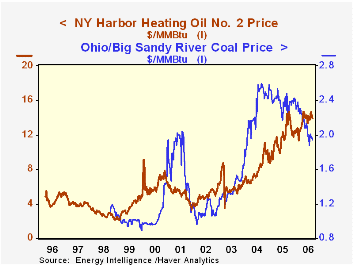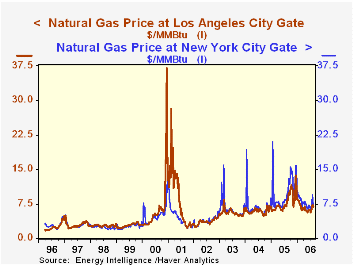 Global| Sep 06 2006
Global| Sep 06 2006How Much Does It Cost To Produce Heat?
Summary
There's a nip of autumn in the air in the New York region, and that change in the weather begins to shift our attention from the price of gasoline to heating fuel costs. Haver has three new databases that help us assess "how much it [...]

There's a nip of autumn in the air in the New York region, and that change in the weather begins to shift our attention from the price of gasoline to heating fuel costs. Haver has three new databases that help us assess "how much it costs to produce heat" and many other energy questions. Coming from Energy Intelligence, a leading oil industry consulting firm, Oil Market Intelligence (OMI), Natural Gas Week (NGW) and World Gas Intelligence (WGI) contain extensive price, supply, demand and stock data for several energy sources in the US and around the world.
For instance, we can compare the cost of various fuels on a common basis, since NGW and WGI contain prices expressed in both the unit each fuel is commonly sold in, as well as in millions of Btu of energy produced. Last week, WTI Cushing crude was priced at $70.54/barrel and $12.16 per million Btu, and heating oil at the New York harbor was $1.9312/gallon and $13.92/MMBtu. By contrast, coal from Big Sandy River, Ohio, was $46.50 a ton, which translates into $1.94/MMBtu.
These databases also facilitate comparisons across geographic markets. So in the winter of 2000/2001, we can quickly see how distorted the natural gas market was in California. As evident from the second graph, the New York "City Gate" price was about $4.50/MMBtu in late summer and peaked over the New Year in a range of $10-$16. It has shown seasonal spikes during the winter in most other years. However, in California, there looks to be only the mildest of seasonal swings then, as one might surmise from the temperate climate there. Except in 2001. In August 2000, the price was $5 to $6. In December it was $26, reaching a peak of $37.12 in the third week of December and remaining above $10/MMBtu until early May. A casual observer [in truth, someone just now passing by my desk] remarked, "my, what was wrong in LA that winter!" Lots. Similarly, it's easy to see the impact of Hurricanes Katrina and Rita in 2005.
The frequencies of these data vary, with some daily, some weekly and some monthly. Coverage of Europe is quite detailed, and supply and demand information on Asia is extensive. These databases, well established in the industry, should be very useful to Haver clients.
| Selected Fuel Prices prices, $ | 9/4/06 | 8/28/06 | July 2006 | Aug 2005 | 2005 | 2004 | 2003 |
|---|---|---|---|---|---|---|---|
| Heating Oil: New York Harbor, $/bbl |
1.9312 | 1.9764 | 1.9270 | 1.7059 | 1.6109 | 1.1089 | 0.8418 |
| $/MMBtu | 13.92 | 14.25 | 13.89 | 12.30 | 11.82 | 8.05 | 6.13 |
| Natural Gas: New York City Gate, $/MMBtu |
5.92 | 7.72 | 6.85 | 9.54 | 10.01 | 6.78 | 6.41 |
| Natural Gas: Los Angeles City Gate, $/MMBtu |
-- | 6.81 | 6.22 | 8.04 | 7.93 | 5.93 | 5.61 |
| Coal: Sandy River, Ohio, $/ton |
46.50 | 47.25 | 46.85 | 57.05 | 56.26 | 54.56 | 32.96 |
| $/MMBtu | 1.94 | 1.97 | 1.95 | 2.40 | 2.38 | 2.28 | 1.38 |
Carol Stone, CBE
AuthorMore in Author Profile »Carol Stone, CBE came to Haver Analytics in 2003 following more than 35 years as a financial market economist at major Wall Street financial institutions, most especially Merrill Lynch and Nomura Securities. She had broad experience in analysis and forecasting of flow-of-funds accounts, the federal budget and Federal Reserve operations. At Nomura Securities, among other duties, she developed various indicator forecasting tools and edited a daily global publication produced in London and New York for readers in Tokyo. At Haver Analytics, Carol was a member of the Research Department, aiding database managers with research and documentation efforts, as well as posting commentary on select economic reports. In addition, she conducted Ways-of-the-World, a blog on economic issues for an Episcopal-Church-affiliated website, The Geranium Farm. During her career, Carol served as an officer of the Money Marketeers and the Downtown Economists Club. She had a PhD from NYU's Stern School of Business. She lived in Brooklyn, New York, and had a weekend home on Long Island.





